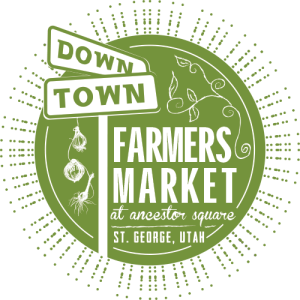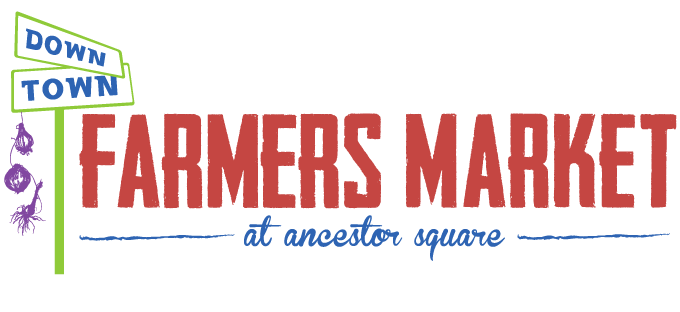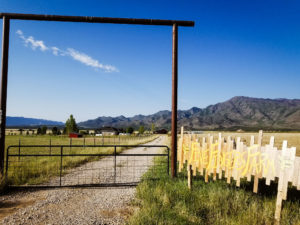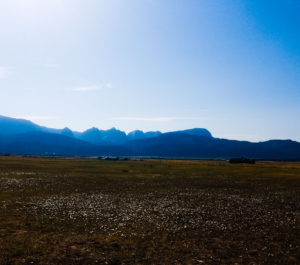Little America Orchard
September has brought the love of Fall to the forefront of everyone’s mind. Even at the market, while we are peddling peppers and popcorn on one end, bat ornaments and Fall themed portraits fill the other. Although some people will tell you that pumpkins are the end all be all of Fall, I will argue that nothing signals the change of season more than the luscious apple. This might cause a riot but fresh cider, dunking for apples, and apple pie defined Fall way before the invasion of the Pumpkin Spice Latte. Apples come on right when Fall starts and carry on throughout the season; unlike the ‘orange trash gourd,’ as my husband calls it. So, imagine my overwhelming delight, when Little America Orchard made their triumphant return to the St. George farmers’ market. They are a certified organic orchard from New Harmony. Being that close and that intriguing I basically demanded an interview upon meeting them. As I headed up on Tuesday, the gloomy weather threatened to ruin my trip, but I stayed positive and persevered.
Google Maps fervently tried to convince me to cut through the cemetery to get to Little America Orchard. When I refused, it directed me further down another side street that promptly ended, leaving only an unmarked gravel lane in front of me. I began to drive up it, thinking that the apple tree lined fence was a fortuitous omen. Almost as if Google sensed my thoughts, it gently chimed that this was not the orchard I was looking for and to continue further up the road. Slowly I gained elevation and popped out on the top of the hillside above the surrounding orchards. I gasped. The trail like road had opened up to a 360-degree panoramic view that reminded me of The Lord of The Rings with the Pine Valley Mountains shooting up directly to my left and epic red rock faces protruding in alarming detail to my right. I lifted my foot slowly off my brake and continued to drink in the scenery. As I slowly rolled onto the magnificent 40-acre plot that is Little America Orchard, I found a place to park and lifted myself, and my dropped jaw, out of the car. Tammy Michie opened the house door and called to me smiling. She hurried out to greet me, at which point she motioned to the orchard and said Gary Suppe was just out there picking up apples and would be up in a second. We stood there talking for a minute as we watched the red pickup circle back to the house.
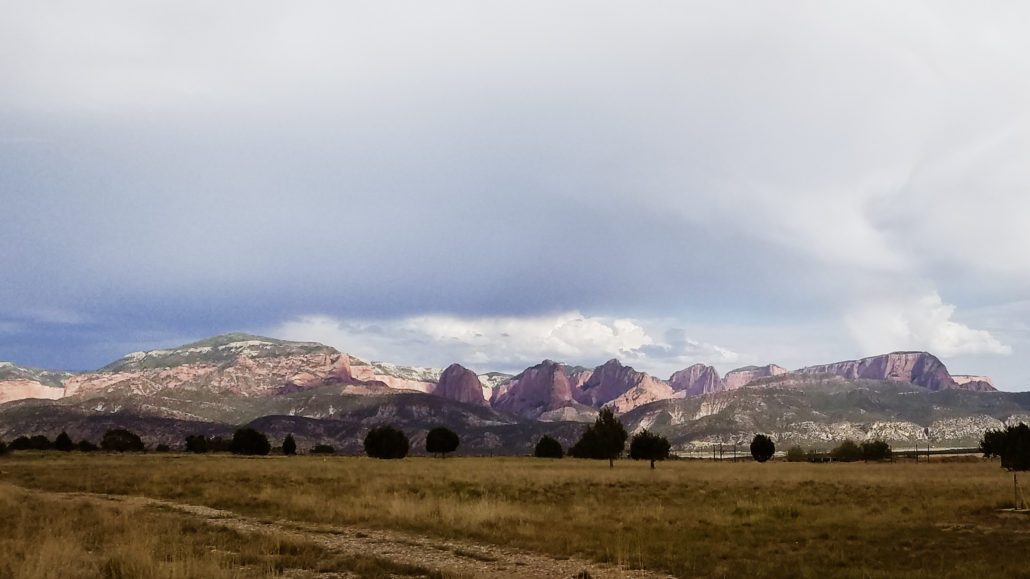
The view off the property
“Man, this is like a story book! Do you just walk out on to your porch and scream ‘YES!’ every morning?” I looked dumbfounded at Tammy. She laughed, “Pretty much! It’s so beautiful here,” Tammy said motioning to the orchard and house, “but all this is Gary.” The red pickup truck pulled in beside us and Gary stepped out. We walked around the truck to meet him, and as we shook hands he motioned to the full flatbed of ‘ground apples.’ “They’re beautiful,” I said as I started to snap pictures. “Ya, I’ll take these and dump them out back for the deer to eat. We don’t use ground apples ever.” Gary stated. I looked at the apples again, some of them were rotten but most of them looked, for lack of a better word, perfect. My mind then immediately jumped to the delicacy of apple fed venison and had to pull myself back to reality. “Well… what do you want to see?” Gary asked. “Everything.” I quickly responded, “I’m nosey.” He laughed a little and nodded then began walking up to the back building. As we approached some stacked apple boxes and a row of tables with a few scales, Gary began explaining their routine, “This is where we do all our processing. We do everything by hand. We pick the apples, clip them, clean them, sort them, then clean them again, and weigh them.” Because they do everything by hand, they can meet special orders and do custom weights. I peered into the boxes overwhelmed by their blush colored contents, then looked up, “Wait… Just the two of you? Or do you have help?” Without a moments hesitation Gary repeated my statement, “Just the two of us.” I raised my eyebrows and looked back over my shoulder at the 250 apple trees. Gary seemed to read my mind, “It’s hard, you know? You can’t hire people when you don’t know how much you’ll make off the apples.” I asked how long his work days were, and he said during long summer days he’ll go out before the sun and come in after dark.
I turned back and mindlessly reached in the box and grabbed an apple for closer inspection. The skin was so beautiful and

The cider press
perfect I could see little reflections on the surface. “Wow,” I said, “This really is a beautiful apple. Is it waxed or something?” I looked up at Gary. His answer was already waiting for me, “No. I don’t use anything like that on my apples. I mean I could use a wax and still be considered organic, but I won’t. That’s just who I am.” I knew he meant it. This also got us talking about the fact that Little America Orchard is USDA certified Organic. A process that you don’t go through unless you are patient and 100% serious. He walked me through the seemingly endless paperwork, the bi-annual visits from inspectors, and the rigorous testing. “Sometimes I roll my eyes and wonder why I do this,” Gary’s tone suggested he was only half joking. He quickly pointed to the bushel behind the table and explained that these were the cider apples. “Do you want to see the cider press?” Tammy asked. I nodded emphatically. Gary walked me over to a door that opened onto an industrial stainless-steel wash basin and uncovered a beautiful, massive, old-fashioned cider press. “WOW!” I squealed. “Is it a hand press?” “Yep, like I said we do everything by hand. We’ll probably start doing cider here at the end of the month.” I started to salivate. I helped him put the cover back on the press, and trailed behind him out the door to join back up with Tammy. We stood out front for a second, when Tammy pointed up the hill and asked if I wanted to see the cooler.
Now, obviously, when there is a cooler on an apple farm, it should be no surprise when said cooler is full of apples. I still was surprised. I was even more shocked when Gary pointed out that, “These are only Galas, when the other varieties start coming on, you won’t even be able to walk in here.” I was positively giddy. Even in a cooler, the fresh delicious apple-y scent permeated everything. Not the synthetic Bath and Body nonsense, but the real stuff. My lizard brain was going crazy as Gary closed the massive door. We turned and looked back at the orchard and began to walk down. “So how many other varieties do you have?” I asked. “Gala, Golden Delicious, Fuji, Cameo, Pink Lady, and Braeburn,” Gary answered quickly and precisely and started listing why he chose these five. He also went into detail about their staggered growing seasons. I was struggling to get my chubby fingers to type fast enough on my phone, I made the note to try voice recording from here on out. Gary told me that he had bought the trees out of Washington in ’03 and as part of the ‘Certified Organic’ process, he had to have them inspected upon purchase. “Wait, I thought you said you started in ’09?” I stopped. “That’s the first year we got fruit off the trees. That’s the first year we certified the fruit. The process started way before that.” I was beginning to see the true scope of the never-ending paperwork Gary had mentioned. “You said this was a childhood dream, did you grow up around apples?” I asked. Gary then described growing up in upstate New York and every October visiting the orchards: doing the U-picks, drinking cider, and being swept up in the spirit of apple season. It wasn’t hard to imagine the magic of those apple orchards when I looked across at Gary’s own little apple filled paradise.

The boxes of beautiful Galas, Gary and Tammy outside the cooler.
As the three of us stepped across the threshold into the orchards, the thought crossed my mind that this was probably hands down the most beautiful orchard in Utah. Gary spaced the trees farther apart than average (13 ft. to be exact) to help mitigate the spread of disease. Dark, lush rows of clover run under the trees to, “Fixate nitrogen into the soil for the trees.” Gary said while reaching up to grab an apple. “Let me show you this one. It’s been so incredibly dry this year that the grasshoppers have cleaned the leaves off of all these trees.” Gary mumbled, in between bites of his apple. “See watch, he knows everything about these trees. He’s out here all the time.” Tammy whispers and nods supportively. I laughed, recognizing this mindset anywhere. It’s something that only happens when you work the same piece of land over and over. It becomes a family member. You do everything in your power to help it succeed and love it even when it’s being difficult. It’s absolutely beautiful to see this connection first hand. Gary finally made it to the row of grasshopper vandalized trees and showed me the raw exposed branches. He then pointed to a few stray apples on the ground. “My chore today is to clear the ground so the rabbits and ants don’t come in.” He joked finishing his apple. “So, a lot of what you do as an Organic grower is proactive.” I commented. “EXACTLY!” Gary answered, “I do everything I can to stop the problem before it starts, because the stuff I spray with every 10 or 15 days you can pretty much eat.” We walked through row after beautiful row. The fruit ranging in color from blush to gold to green to pink against the gray skies. Gary pointed out the different shades, saying things like, “You won’t see that in a chemical apple.” When I asked him to elaborate, he told me about all the different chemicals you can put on a tree not just pesticides. “You know that cooler up there? Big orchards will have a bunch of them. They’ll fill it with apples and put a chemical in there commonly called ‘smart fresh’ seal it up, and as long as it stays sealed those apples will keep for up to two years.” My stomach turned, and I think from the look on my face, Gary could tell he had sold me.

Clockwise from the left: Gary inspecting grasshopper damage, apples, apples , and more APPLES!
We circled back toward the house and Gary mentioned that he had to feed his gigantic Koi fish. “What?” I stopped. “Do you want to feed them?” He asked. “Yes, yes I do.” We walked around the deer apples and talked about food and farming. He pointed out neighboring orchards and ponds. We approached the gigantic man-made pond and he whistled for the Koi to come. As he sprinkled the food pellets hundreds of mouths and different patterns emerged out of the water. I laughed and tried to get pictures. “Do you have these for fun?” I chuckled. “No, I sell them too sometimes. Mostly to places in Vegas, but they’re fun.” He explained sizes to me and patterns and then we walked back toward the house, where Gary disappeared into the orchard again and Tammy took me around the house. While we were standing on the deck, I turned to her and said, “Well what if I never want to leave?” Tammy laughed and understandingly said, “Everyone says that.” I smiled at her and thanked her for sending me off with a few bags of apples. On the way out, I stopped a record breaking five times to take pictures. I smiled all the way home. When I unloaded, I cut up an apple to share with my son and husband. I am not ashamed to admit, that after my first bite I immediately took all the pieces out of their hands and grabbed the plate and ate my apple alone in a corner. They’re that good.

The beautiful orchard
If you would like to get your hands on some apples from Little America Orchard, they will be selling at the Downtown Farmers’ Market at Ancestor square for the rest of the season or you can reach them at littleamericaorchard@hotmail.com or by phone at (435) 414-5554.
